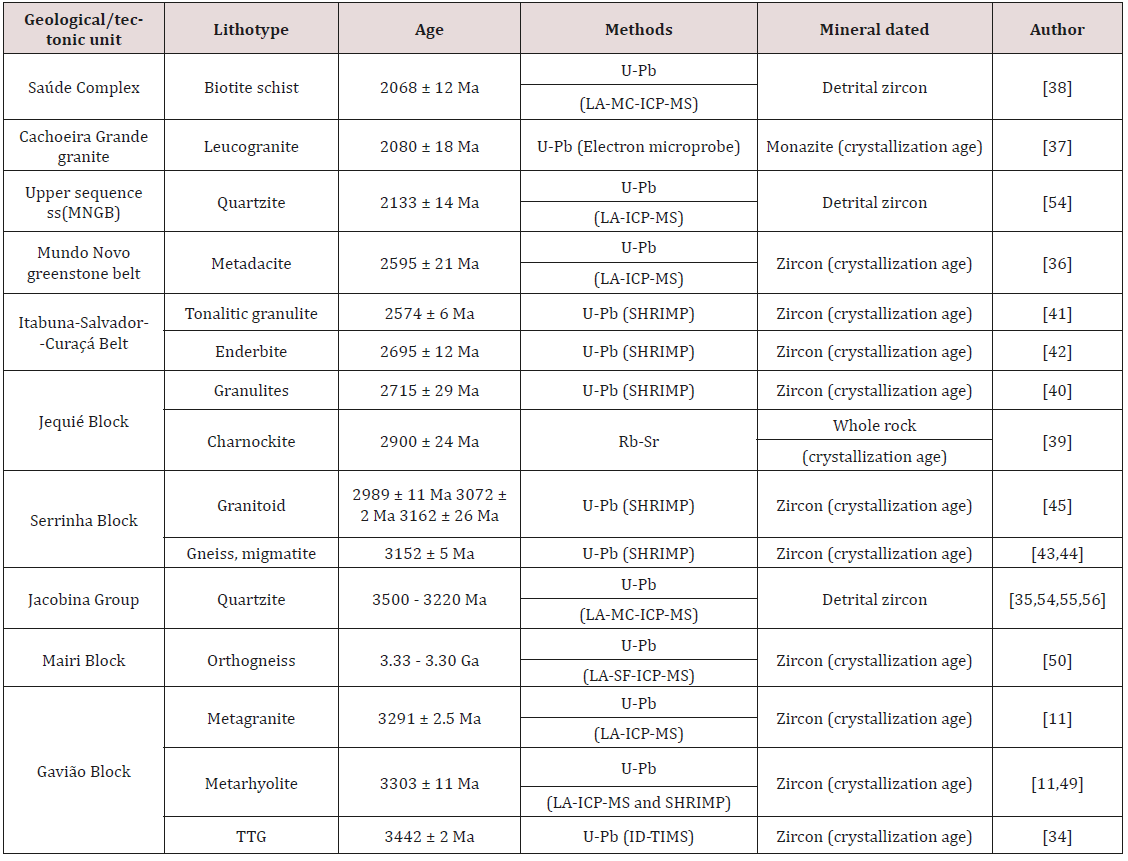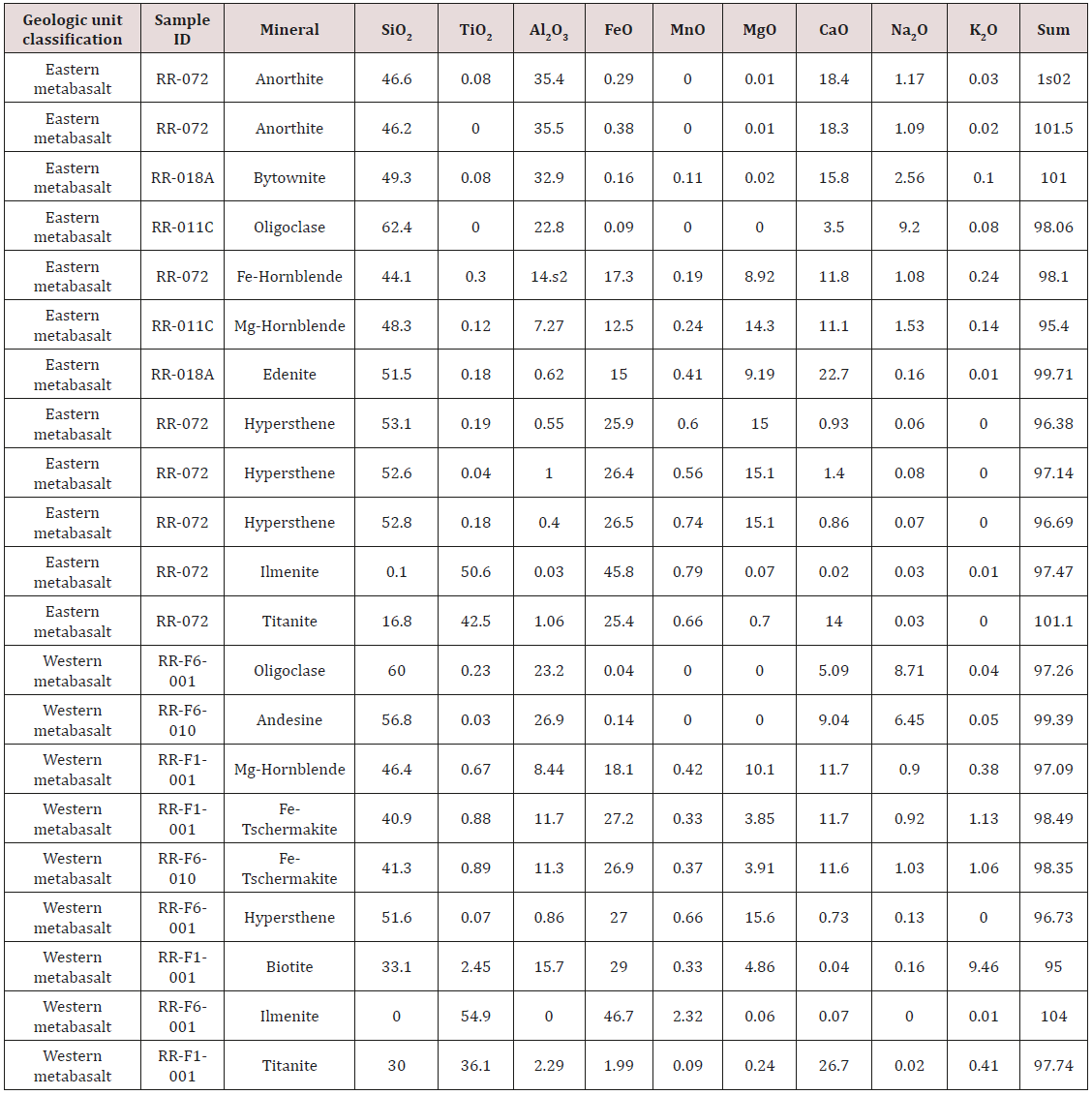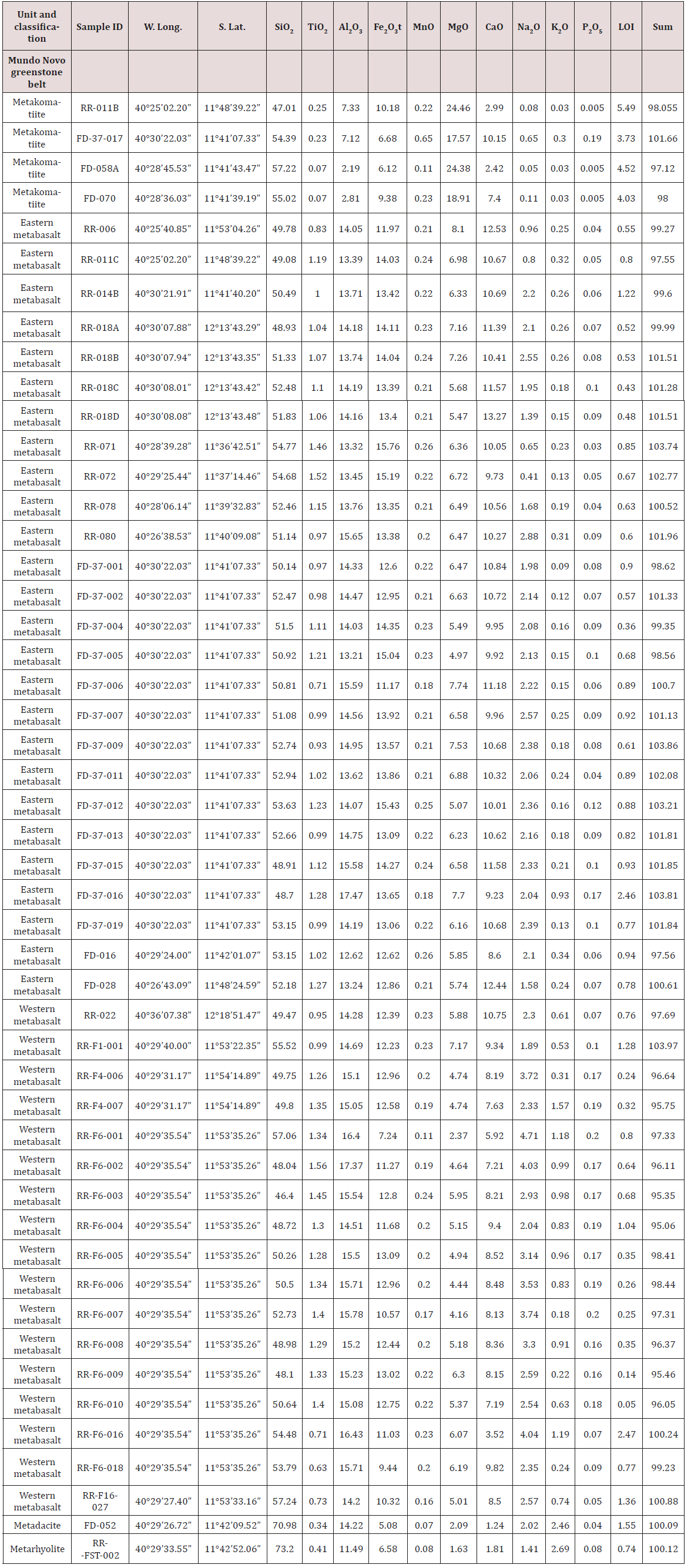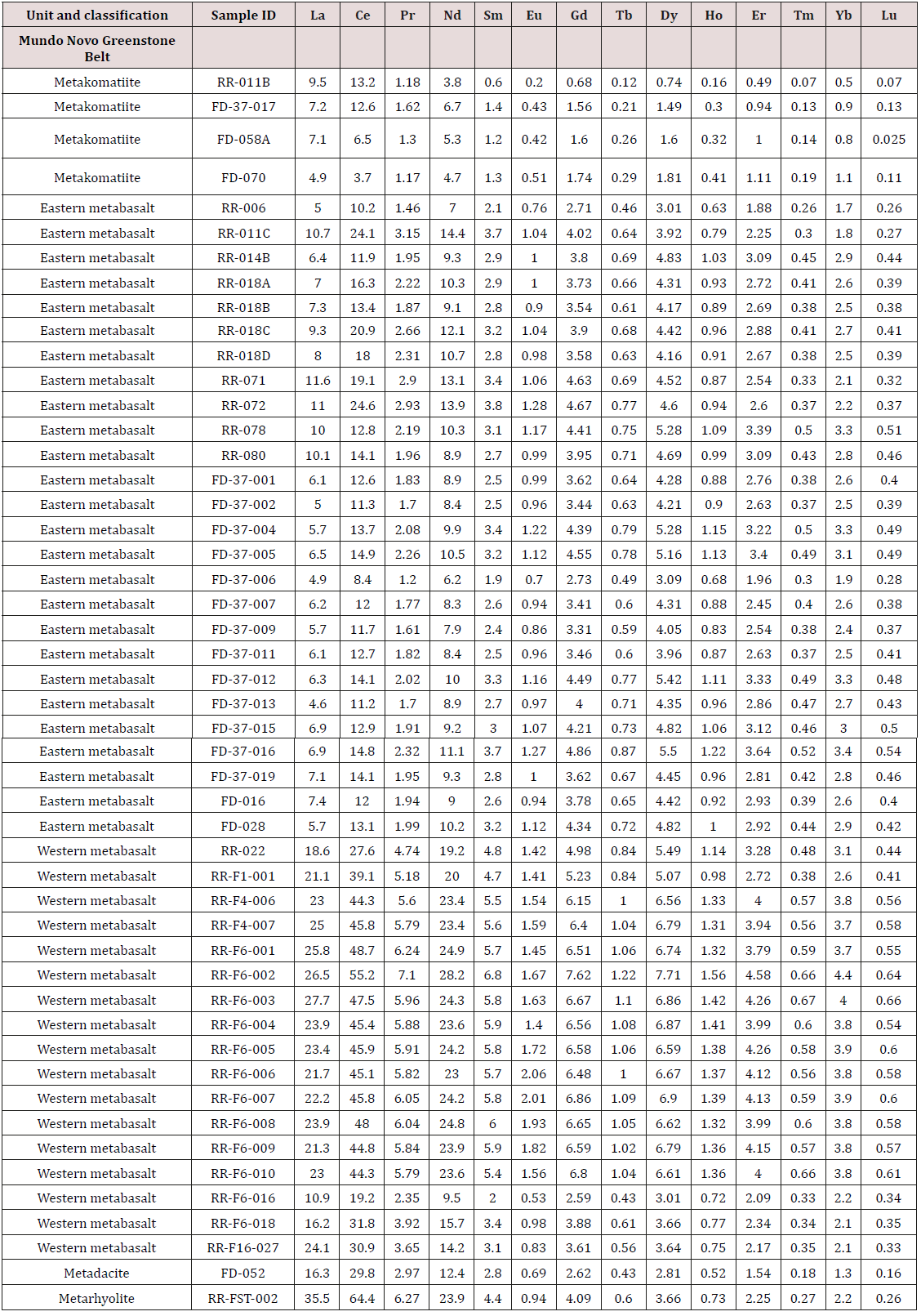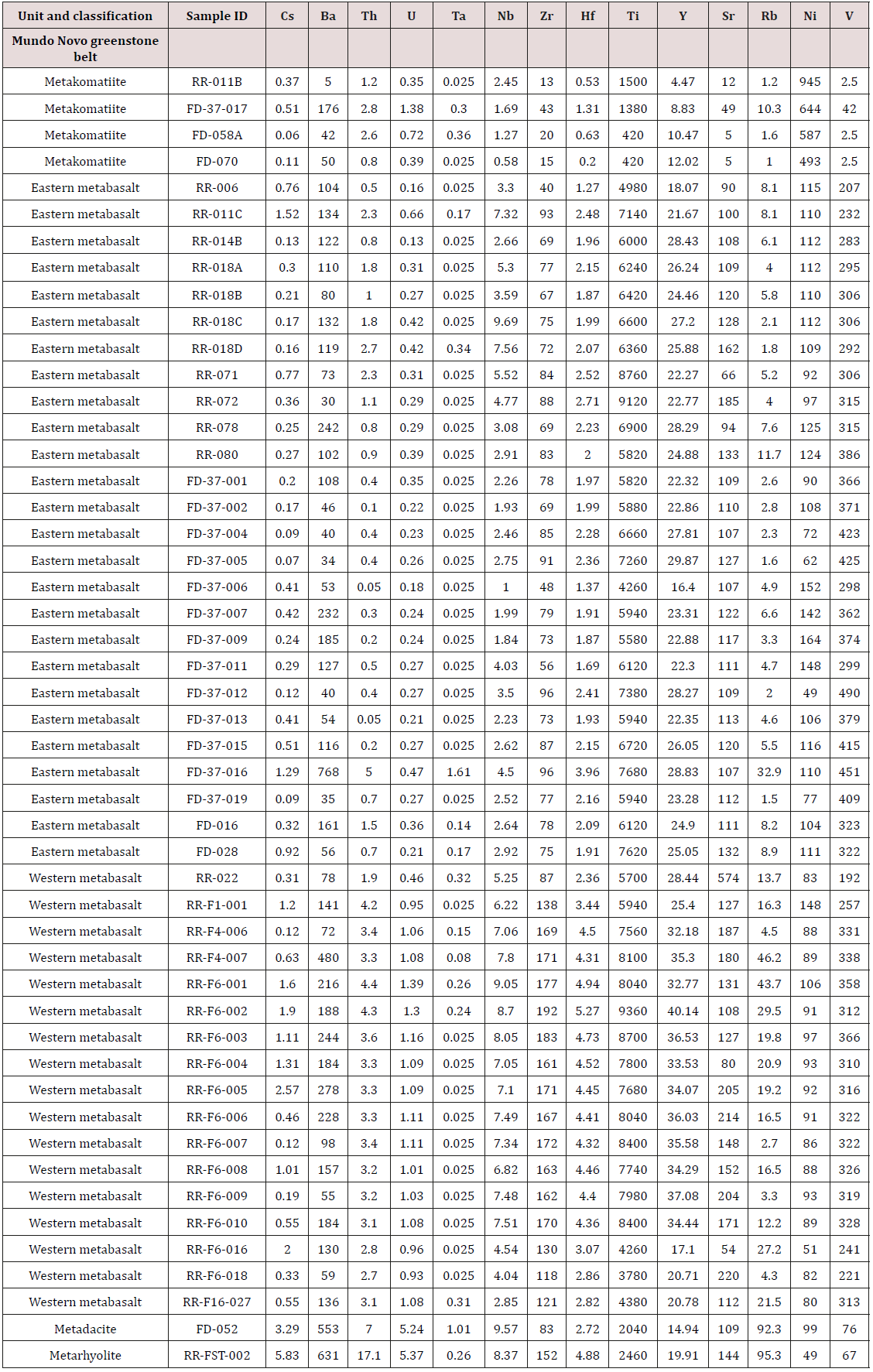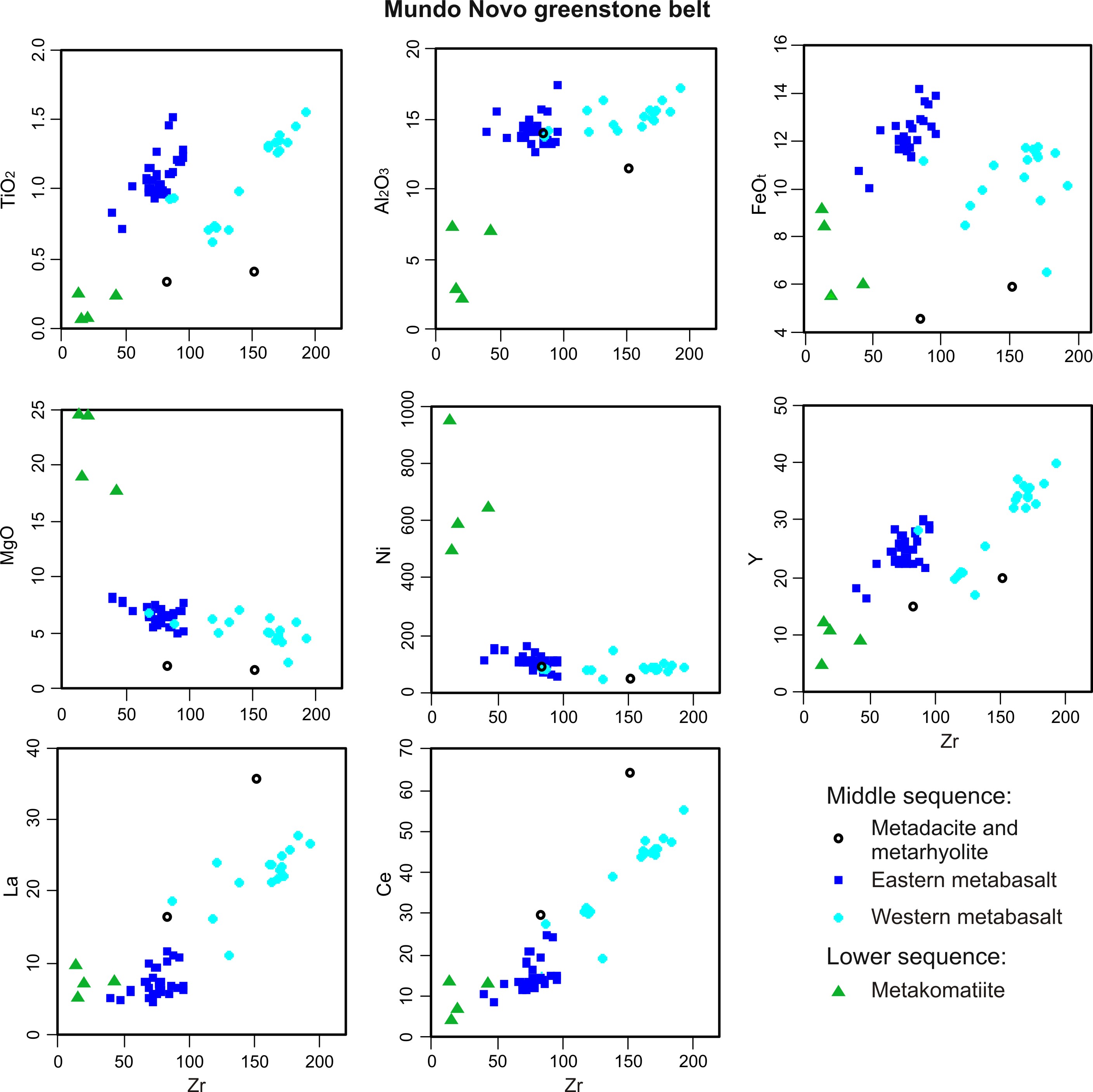
Lupine Publishers Group
Lupine Publishers
Menu
ISSN: 2690-5779
Research ArticleOpen Access 
Geology and Petrology of Metavolcanic Rocks in the Neoarchean Mundo Novo Greenstone Belt, Eastern São Francisco Craton, NE Brazil: Tectonic Setting Considerations Volume 1 - Issue 1
Ricardo Ramos Spreafico1* ,Johildo Salomão Figueiredo Barbosa1, Antônio Marcos Vitória de Moraes2 and Francisco Dias de Souza Júnior2
- 1Institute of Geosciences, Federal University of Bahia, Brazil
- 2Mining Company of Bahia State, Brazil
Received: October 29, 2019 Published: November 12, 2019
Corresponding author: Ricardo Ramos Spreafico, Mining Company of Bahia State and Institute of Geosciences, Federal University of Bahia, Brazil
Abstract
Field and petrological data of metakomatiite, eastern and western metabasalts and metadacite were used to propose an intraoceanic or intracontinental provenance for the Neoarchean Mundo Novo Greenstone Belt (MNGB), eastern São Francisco Craton. Despite deformation, the metakomatiite preserves the spinifex texture and the eastern metabasalt’s pillow lava structure. The metavolcanics are recovered by an ocean floor lithological association composed of chemical metasedimentary rocks and the western metabasalt hosts ocean floor hydrothermal alteration zones. The eastern metabasalt plots in the IAT and MORB fields and western metabasalt is mainly in the MORB field in the Zr vs. Zr/Y diagram, suggesting nearby oceanic settings. Heterogeneous crustal assimilation and metamorphism during the Rhyacian-Orosirian explain the mineralogical differences between the two metabasalts. The metakomatiite and metabasalts feature a vector from the MORB-OIB array to the volcanic arc array in the Nb/Yb vs. Th/Yb diagram, similar to the intraoceanic arc-basin system of the Archean greenstone belts. The average (La/Yb) N ratio of 8.87 for the metadacite indicates a crustal contamination in subducting oceanic crust. An intraoceanic provenance in arc-basin settings and oceanic crust assimilations are proposed for the Neoarchean MNGB, which was posteriorly compressed between cratonic blocks during the Rhyacian-Orosirian and lies in the Contendas-Jacobina Lineament.
Keywords: Mundo Novo Greenstone Belt; metavolcanic rocks; Intraoceanic Setting; Petrology; São Francisco Craton
Introduction
The Neoarchean Mundo Novo greenstone belt (MNGB), in the eastern boundary of the Gavião Block [1-3] and eastern portion of the São Francisco Craton, and lying within the Contendas-Jacobina Lineament [4], NE Brazil, hosts the Zn-Pb Fazenda Coqueiro deposit and has been a subject of study since the 1970s [5-12] (Figures 1A-1C). However, the MNGB lacks detailed discussions on its tectonic setting of volcanism, mainly concerning its intraoceanic or intracontinental provenance. Greenstone belts are highly varied Archean geological entities that contain a vast diversity of rocks. Generally, their rocks experienced multiple stages of deformation, metamorphism and metasomatic alteration due their great age and diversity of geotectonic settings, which was intruded by mafic, ultramafic and granitoid rocks [13]. Moreover, the intraoceanic or intracontinental provenance of volcanic rocks in Archean greenstone belts has been a recurring discussion topic and whole-rock chemical tools have been constantly applied for such research purposes [14-17]. The predominance of subaqueously deposited basalt and komatiite has been interpreted in a wide variety of geological settings proposed for greenstone belt terrains in intraoceanic crust, ranging from primitive island arcs to plume-related submarine plateaus, mid-ocean ridges (including ophiolites) and back-arc basins [18-22]. Furthermore, the intraoceanic Archean greenstone belts present a set of evidence as follows: basalt and komatiite occurrence, the absence of zircon xenocrysts, Mid-Ocean Ridge Basalt (MORB) and Island Arc Tholeiitic (IAT) geochemical patterns, and Th enrichment due to crustal contamination processes [16]. The crustal contamination, however, would have been produced by subduction components, metamorphism, intraoceanic contamination, crustal recycling, high Th-Nb proxy and delamination [16,17].
Figure 1: A) Location of the São Francisco Craton in NE Brazil. B) Study area in the eastern portion of the São Francisco Craton and other greenstone belts and volcano-sedimentary sequences: CM: Contendas-Mirante; RV: Rio das Velhas; UM: Umburanas. C) Regional tectonic setting where the MNGB is inserted (modified from Barbosa and Sabaté [1,2,3]). Ages in the points highlighted on the map: 1- 3442 ± 2 Ma (U-Pb zircon, TTG; Mougeot [34]); 2- 3303 ± 11 Ma (U-Pb zircon, metarhyolite from the Gavião Block obtained by Zincone et al. [11]); 3- 3292 ± 3 Ma (U-Pb zircon, metagranite from the Gavião Block obtained by Zincone et al. [11]); 4- 3500 - 3220 Ma (U-Pb zircon, quartzite from the Jacobina Group obtained by Teles et al. [35]); 5- 2595 21 Ma (U-Pb zircon, metadacite from the MNGB obtained by Spreafico et al. [36]); 6- 2080 18 Ma (U-Pb monazite, Cachoeira Grande granite obtained by Leite [37]); 7- 2068 12 Ma (U-Pb zircon, biotite schist from the Saúde Complex obtained by Zincone et al. [38]).
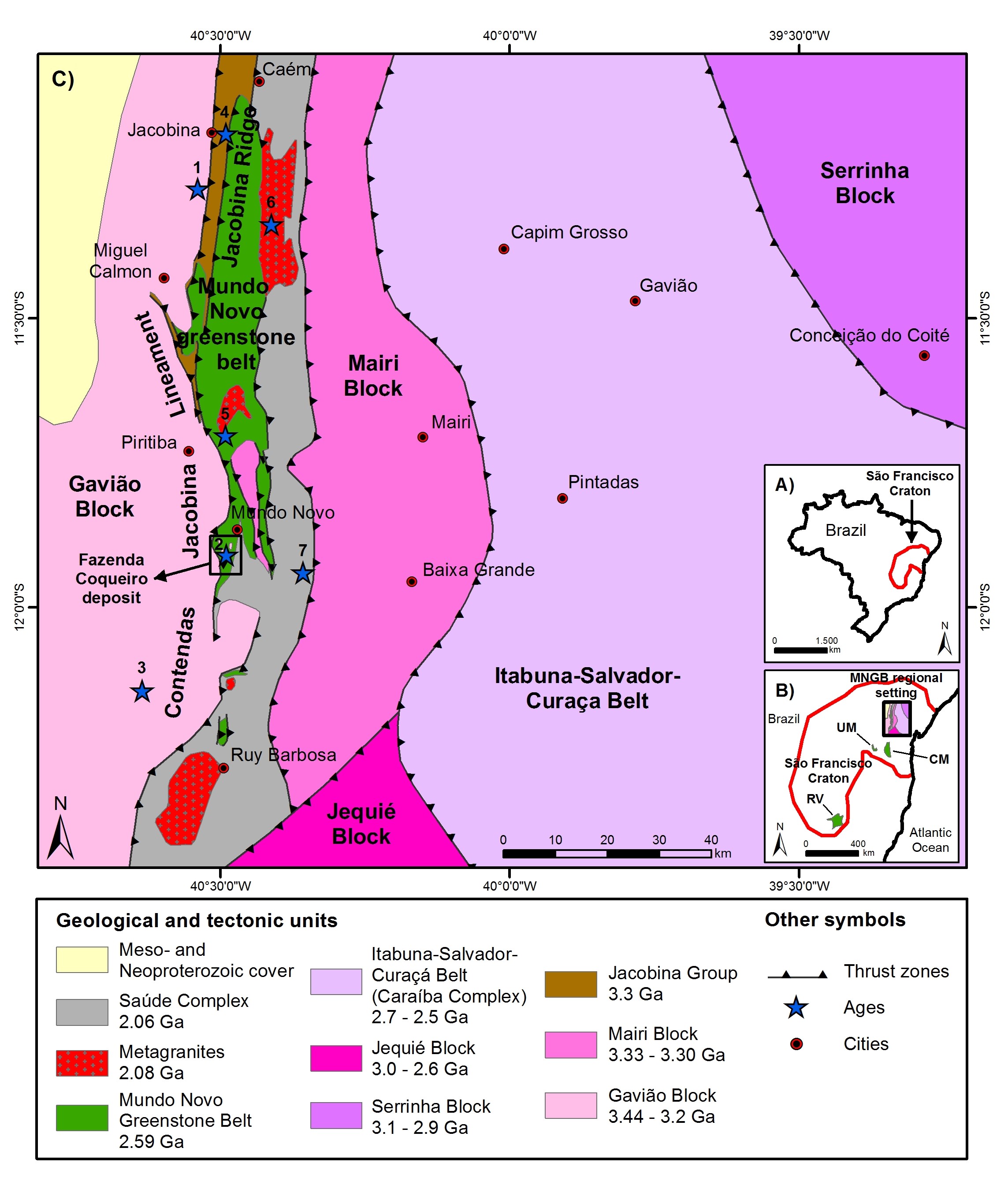
The metabasalt of the Nova Lima Group in the Archean Rio das Velhas greenstone belt of the southern São Francisco Craton (Figure 1B), for example, has been considered as derived from an oceanfloor setting based on a pillow lava structure and an association with chemical sediments and volcanic rocks [23]. Moreover, the geochemical pattern of this metabasalt suggests a submarine plateau setting and crustal contamination rocks; the felsic volcanic rocks would indicate the presence of an island arc or back-arc type setting [24]. In the Neoarchean Contendas-Mirante volcanosedimentary sequence, south of the Contendas-Jacobina Lineament Figure 1b, which contains geochemical and age equivalences with the MNGB, intraoceanic basalt occurrences have been interpreted as being related to banded iron formation [25]. The South Abitibi [26,27], Barberton et al. [21,28,29] and Isua et al. [15,30] are other examples of intraoceanic interpretations for Archean greenstone belts, which Pearce [16] discusses in his examination of the ocean floor’s origin with crustal contamination along their geological evolution based on a Th-Nb proxy. Despite the contamination issues of analyzing Archean rocks, the geochemical pattern of the modern Mariana Arc, which indicates an arc-basin system in oceanic crust, was properly used to compare to older intraoceanic settings in the Nb/Yb vs. Th/Yb diagram [16,31]. The intracontinental provenance of volcanic rocks in Archean greenstone belts, on the other hand, has been related to oceanic-continent subduction processes or with the genesis on ensialic settings [16]. Greenstones of the Wawa belt in the Superior Province, for example, were formed in an arc-related association [14], the Umburanas greenstone belt in the eastern São Francisco Craton Figure 1B was formed over a continental crust [32]. Bickle et al. [33] concluded that the continental provenance for Archean greenstone belts could not easily identify complete ophiolitic sequences, which would thus explain a possible oceanic origin; the presence zircon xenocrysts, geochemical and isotopic evidence for crustal contamination, intrusive relationships with older basement rocks and their internal stratigraphy would also indicate continental provenance. Therefore, field, petrographic and whole-rock chemical data from the metakomatiite, eastern and western metabasalts and metadacite in the MNGB, completed by the mineral chemistry of the two metabasalts, were used to characterize the metavolcanic rocks and study the tectonic setting of the MNGB. The intraoceanic provenance of the volcanic rocks rather than the intracontinental provenance and a comparison with other Archean greenstone belts were also considered. The insertion of the Neoarchean MNGB within the regional geologic context in the eastern portion of the São Francisco Craton and the subsequent tectonic events were also contemplated.
Geological Setting
The eastern portion of the São Francisco Craton, where the MNGB is situated (state of Bahia), was formed through the amalgamation of four Archean blocks during the Paleoproterozoic continentcontinent collision [1-3] the Gavião, Serrinha and Jequié blocks and the Itabuna-Salvador-Curaçá Belt Figure 1c. The Paleoproterozoic event captured the MNGB and surrounding crust between the cratonic blocks, and the uplift caused by this event possibly resulted in the erosion and the formation of Paleoproterozoic sedimentary basins, such as the uppermost sequence of the MNGB and the Saúde Complex. Briefly, the MNGB is in contact to the west with 3.4 Ga [34] Tonalite-Trondhjemite-Granodiorite (TTG) basement rocks and subordinate metagranites in the Gavião Block and to the east and south with paragneiss in the Saúde Complex with a maximum age between 2.20 and 2.06 Ga [38] Figure 2. To the north and northwest, the MNGB is in contact with quartzites in the Jacobina Group, which were deposited between 3.55 and 3.22 Ga [35], and Paleoproterozoic granitic intrusives. Additionally, the geological setting includes granulites (3.0 Ga) and multiple charnockite intrusions (2.7 and 2.6 Ga) in the Jequié Block et al. [39,40], the Itabuna-Salvador-Curaçá Belt (2574 ± 6 Ma and 2695 ± 12 Ma obtained by Oliveira et al. [41], Silva et al. [42]; respectively, and the Serrinha Block 3152 ± 5 Ma obtained by Oliveira et al. [43,44]; 2989 ± 11 Ma, 3072 ± 2 Ma and 3162 ± 26 Ma obtained by Rios et al. [45], although the Itabuna-Salvador- Curaçá Belt and Serrinha Block are far from the MNGB, they are important for understanding the collisional Paleoproterozoic tectonic context of the study area Figure 1C. Table 1 shows regional geochronological data from the MNGB and surrounding units. The eastern margin of the Gavião Block is in tectonic contact with the lithologies of the MNGB Figure 1C and is composed of TTG gneiss and migmatites that host mafic rock enclaves [46], metagranites and metarhyolites [11]. This block corresponds to the basement of the MNGB. Three groups of TTG gneiss are described in the Gavião Block: two groups are trondhjemitic with U-Pb zircon ages (SHRIMP) of 3403 ± 5 Ma and 3158 ± 5 Ma [47,48], and the other group, with granodioritic compositions, includes the 3225 ± 10 Ma Aracatu granitoid [46]. The Gavião Block age, near the MNGB, is 3.4 Ga [34], but metarhyolites with ages of 3303 ± 11 Ma [11,49] and metagranites, such as Boa Sorte at 3291 ± 2.5 Ma, occur as well [11].
Figure 2: Geologic map of the MNGB and adjoining units. Modified and updated from Loureiro [8], Mascarenhas and Silva [9] and Souza et al. [69].
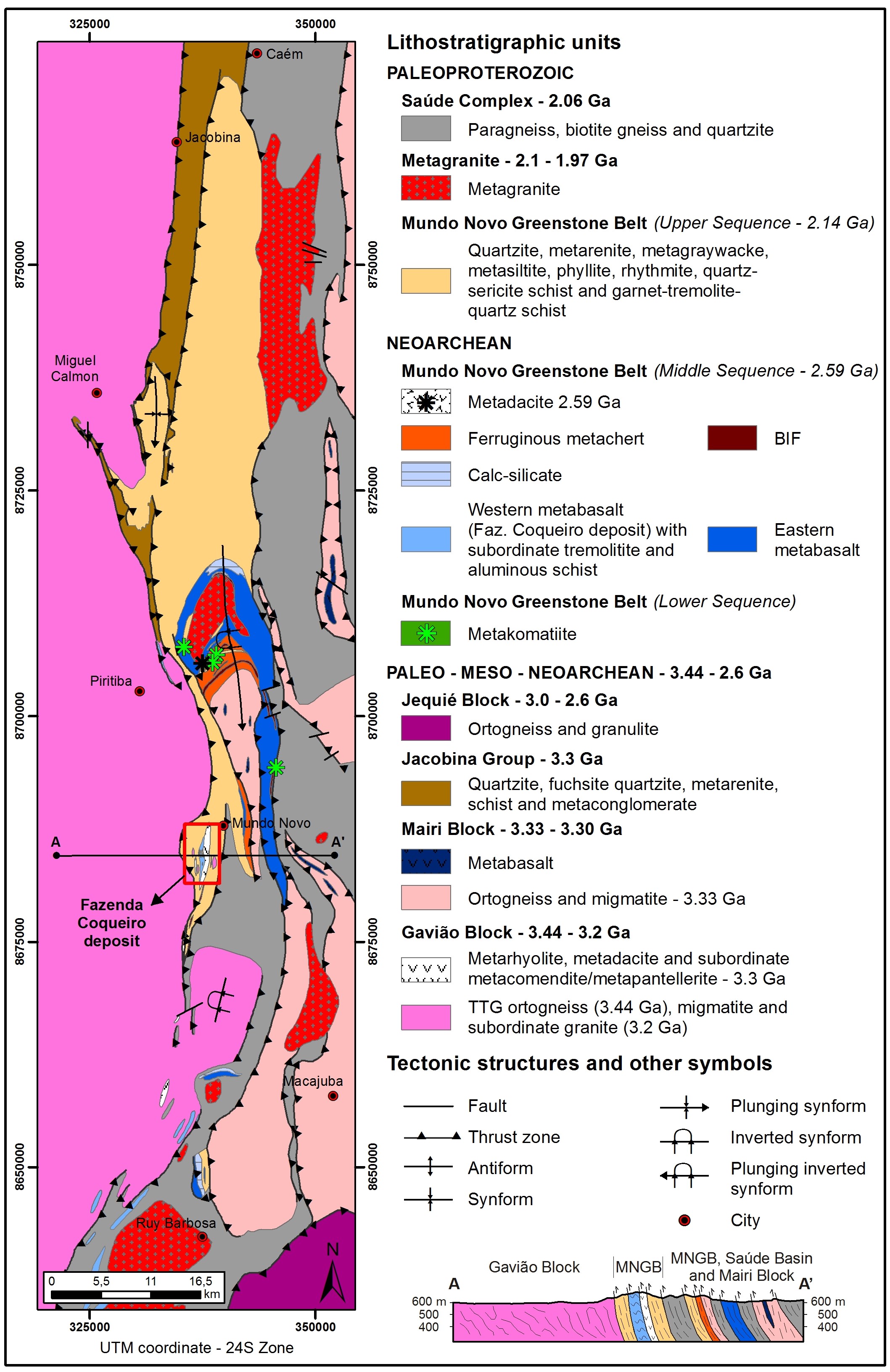
The Mairi Block, composed of gneiss, migmatites, and granitic and tonalitic orthogneiss, with some occurrences of basic and ultrabasic bodies [49] to the east and southeast of the MNGB, is in tectonic contact with thrust zones with a west vergence. The LA-ICP-MS U-Pb zircon ages of 3.33 Ga and 3.30 Ga [50] for the orthogneiss in the Mairi Block indicate that this complex is coeval with the Gavião Block and, therefore, the two may have been joined at the time of their formation. The Jacobina Group is in tectonic contact with the MNGB along thrust zones, with all zones striking north south and verging to the west Figure 1c with the Gavião Block in the footwall. The Jacobina Group comprises metaconglomerates that host an important gold deposit, quartzites, metarenites, phyllites, chlorite schists and quartz-sericite schists [10] deposited in a passive margin setting [51]. This group has a depositional age, based on detrital zircons, between 3500 Ma and 3220 Ma [35,54,55], with a large portion of the zircon populations situated between 3.3 Ga and 3.4 Ga [35,56]. Jacobina Ridge represents an Archean supracrustal sequence with a maximum age of 3.28 Ga, and its sources are likely rocks from both the plutonic-volcanic system and the TTG suite in the Gavião Block [11].
The MNGB, which Zincone et al. [11] referred to as the Mundo Novo supracrustal belt, is inserted into the Contendas-Jacobina Lineament and is divided into three stratigraphic sequences - a lower sequence (ultramafic rocks), a middle sequence (mafic and felsic igneous rocks and clastic and chemical metasedimentary rocks) and an upper sequence (siliciclastic metasedimentary rocks; [36]). Carbonate and argilic-chloritic hydrothermal alteration zones in the ocean floor setting have been identified and described in the Fazenda Coqueiro deposit related to Zn-Pb mineralization hosted in the western metabasalt of the middle sequence [52]. Two ductile and compressional and progressive Paleoproterozoic deformational phases in the MNGB, D1 and D2, are described in the area in a previous study [52]. The D1 deformational phase is characterized by isoclinal and recumbent folds vergent to the west that generated greenschist metamorphic facies rocks. The D2 deformational phase is characterized by a refolding that generated vertical and subvertical axial planes that eventually resulted in the formation of a coaxial interference pattern [53] or compressive and transpressive shear zones, which bound the MNGB lithologies and generated greenschist rocks to amphibolite metamorphic facies. The most prominent brittle structures are east-trending faults and fractures. The age of the MNGB has been previously studied, and geochronological studies have defined the Neoarchean age of the volcanism [36], such as the Paleoproterozoic sedimentation on the top of the sequence [54], which is coeval with the Rhyacian- Orosirian tectonothermal event [37,52]. These rocks lie upon the 3.4 - 3.2 Ga basement rocks of the northern part of the Gavião Block comprised of TTG gneiss, metagranites and metarhyolites [11,34,46,47,48,49]. The Saúde Complex occurs to the east of the MNGB Figure 1c, where the two units are in tectonic contact along west-vergent thrust zones. This complex comprises aluminous paragneiss, biotite gneiss and subordinate quartzites that are widely distributed in a north-south trend with significant occurrences in the Mundo Novo region and in the eastern portion of the Jacobina Ridge et al, [7,10,12,57] Figure 1C. The maximal depositional age of 2.06 Ga [38] for the Saúde Complex again indicates the presence of a basin near the MNGB in the Paleoproterozoic; however, the rocks in the Saúde Complex were subjected to a higher metamorphic grade than the sedimentary rocks at the top of the MNGB along the tectonic contact.
Finally, Rhyacian-Orosirian granites are present along the Contendas-Jacobina Lineament [37,52] Figure 1C. In general, these granites are undeformed leucogranites, comprising quartz, feldspar, biotite and muscovite with some occurrences of garnet and sillimanite [58]. The Cachoeira Grande granite, for example, is a peraluminous leucogranite situated to the northeast of the MNGB, which has an average age of 2080 ± 18 Ma [37] and is coeval with the Rhyacian-Orosirian granitic intrusions in the MNGB [36,52].
Materials and Methods
The study of the metavolcanic rocks of the MNGB and considerations of the tectonic setting involved petrography, mineral chemistry and whole-rock chemical analyses. For petrography, we analyzed 127 thin sections of metakomatiite, eastern and western metabasalts and metadacite to determine the mineralogical composition, textures and microstructures of the rocks using the ZEISS Axio Scope.A1 microscope provided by Companhia Baiana De Pesquisa Mineral (CBPM). The mineral abbreviations used on photomicrographs mainly follow those of Kretz [59] and Siivola and Schmid [60] and are completed with abbreviations of Whitney and Evans [61]. Six of the thin sections were used for mineral chemistry analysis to detail the mineral differences between the two metabasalt types complementing the petrographic studies. Thus, a CAMECA SX50 electron microprobe was used with four Wavelength-Dispersive Spectroscopes (WDS) and one Kevex Energy Dispersive Spectroscope (EDS) of the University of Brasília. The standards used are naturals and synthetics with defined compositions, such as albite (for the element Na2O), andradite (for the elements CaO and FeO), forsterite (for the element MgO), microcline (for the elements Al2O3, SiO2 and K2O), MnTiO3 (for the element TiO2) and MnTiO3 (for the element MnO). The analyzed spots were selected on polished sections in plagioclase (6 spots in 5 samples), amphibole (6 spots in 5 samples), pyroxene (4 spots in 2 samples), ilmenite (2 spots in 2 samples), titanite (2 spots in 2 samples) and biotite (1 spot in 1 sample) grains Table 2. The chemical contents are expressed by SiO2, TiO2, Al2O3, FeO, MnO, MgO, CaO, Na2O and K2O. The data were processed using the Gabbrosoft spreadsheets (http://www.gabbrosoft.org) and the plagioclase results were plotted in the ternary diagram of feldspar; the amphiboles were plotted in the calcic amphibole diagrams [62] and the pyroxene in the classification diagram of pyroxenes [63] using the Minpet program. The EDS data were used to show evidence of manganiferous ilmenite, and in this case, a backscattered electron image was obtained.
The whole-rock chemical analysis of 49 samples was conducted in the SGS-Geosol laboratory. The samples were dried and crushed so 75% of the sample was smaller than 3 mm. A 300 g sample was quartered and pulverized (until 95% was smaller than 105 microns) to form a powder for subsequent processes. The powders were melted at a high temperature with lithium metaborate, and the major, minor, trace, and Rare Earth Elements (REE) were determined using ICP-MS and inductively coupled plasma optical emission spectrometry (ICP-OES) analysis. The international standard samples used are TILL-3 (a description and values are in Lynch et al. [64]) and GRE-05 (reference material from Geostats PTY Ltd.). The error for all analyzed elements in each sample was calculated based on analytical accuracy according to the content of the analyte in the sample, the statistical detection limit and the repeatability limit, and represented in terms of standard deviation (1σ) [65]. The coefficient of variation of the analytical results for each element by sample analyzed, calculated from the standard deviation (1σ), was predominantly lower than 15%, which corresponds to wellrepresented results around the arithmetic mean. Only the samples with a Loss on Ignition (LOI) values of ≤ 5% were considered. The geochemical data were plotted and interpreted using the GCDKit software [66]. The data in the REE diagram and the (La/Yb) N, Eu/ Eu* and (Gd/Yb) N ratios were normalized by chondrite values [67], and the data in the multielement diagram were normalized by N (normal)-MORB values [68].
Results
Geological, Petrographic and Mineral Chemistry Characterization
The geologic characterization of the Neoarchean MNGB, which was carried out to support interpretations of the tectonic setting, consisted of field and petrographic observations performed in metavolcanic rocks, including metakomatiite, eastern and western metabasalts and metadacite Figure 2. The mineral chemistry was used to detail petrographic analyses in the eastern and western metabasalts.
Mundo Novo Greenstone Belt
Many Paleo- to Neoarchean greenstone belts have been characterized as volcano-sedimentary sequences deformed and metamorphosed over time at low to medium grades; they show, from the base to the top, a progressive variation from volcanic (ultramafic, mafic and felsic rocks) to sedimentary rocks (chemical and clastic rocks); they are commonly associated with orthogneisses and are intruded by syn- to posttectonic granites [13]. Based on these concepts, the MNGB is interpreted as part of a typical greenstone belt terrain and is divided into three stratigraphic sequences: the lower sequence, composed of metakomatiite; the middle sequence, composed of eastern and western metabasalts and, subordinately, tremolitite, calc-silicate rock (carbonate hydrothermal alteration zone), aluminous schist (argilic-chloritic hydrothermal alteration zone), BIF, ferruginous metachert, metadacite and metarhyolite; and the upper sequence, composed of siliciclastic metasedimentary rocks, such as metarenite, quartzite, metagraywacke, metasiltite, phyllite, rhythmite, quartz-sericite schist and garnet-tremolitequartz schist Figure 2. This study focused on metavolcanic rocks of the lower and middle sequences.
Lower Sequence
Figure 3: A) Typical spinifex texture of the MNGB metakomatiite. B) Highlighted pillow lava structure of the eastern metabasalt from south of the MNGB. C) Drill hole sample of the western metabasalt in the MNGB. D) Drill hole sample of the porphyroclastic metadacite in the MNGB.
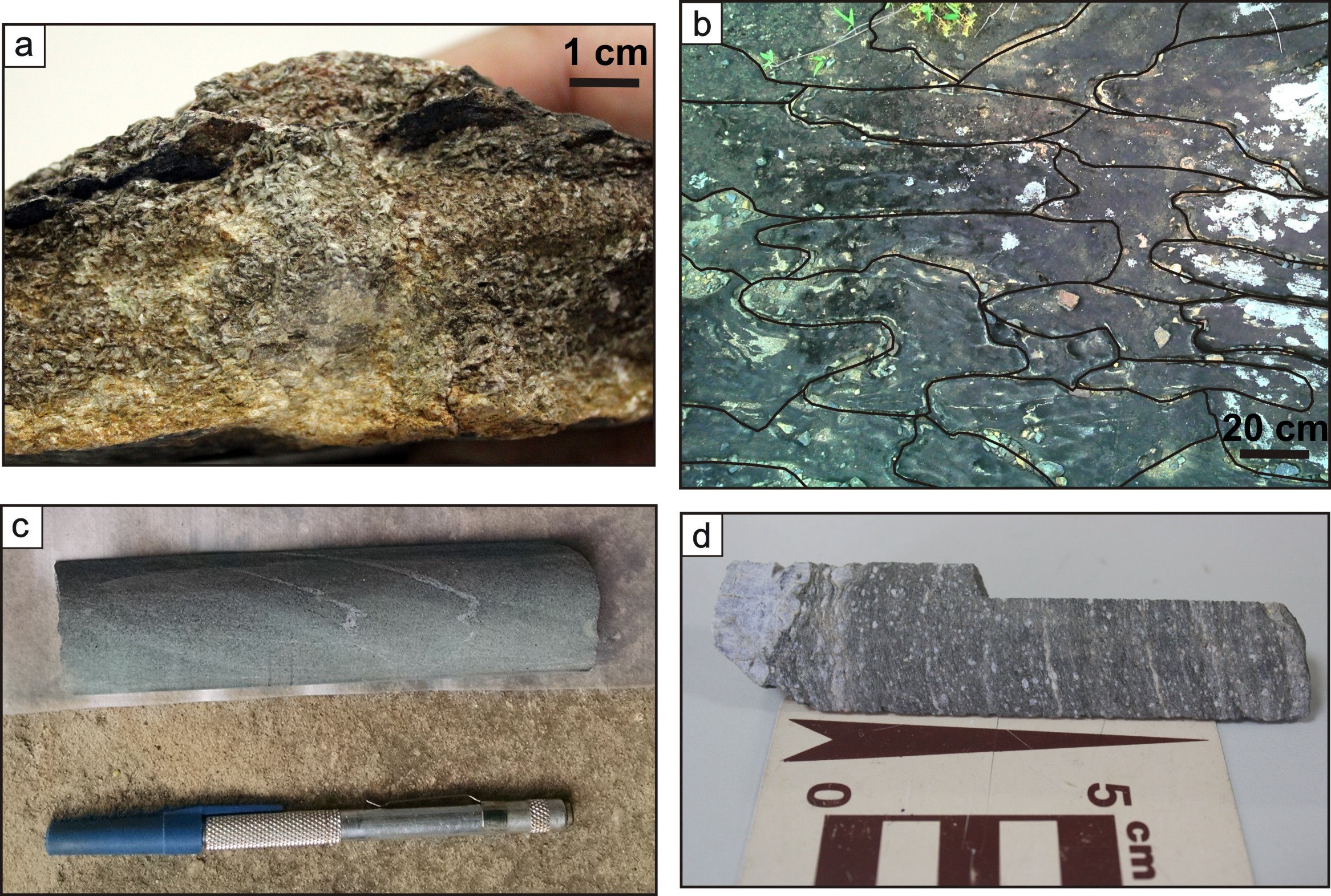
Figure 4: Petrographic images of the MNGB: A) Spinifex texture of metakomatiite composed of pseudomorphic anthophyllite lath in a fine-grained groundmass of talc (XP, 2.5×; sample FD-058A). B) Granonematoblastic texture of the eastern metabasalt (XP, 10×; sample RR-018A). C) Typical very fine-grained texture of the western metabasalt (XP, 10×; sample RR-F6-001). D) Porphyroclast of plagioclase with a sericitized border in a fine-grained groundmass of quartz, biotite and muscovite in the metadacite in the middle sequence of the MNGB (XP, 10×; sample FD-052). Mineral abbreviations: Act: actinolite, An: anorthite, Ath: anthophyllite, Aug: augite, Bt: biotite, Byt: Bytownite, Ccp: chalcopyrite, Hbl: hornblende, Ilm: ilmenite, Ms: muscovite, Olg: oligoclase, Pl: plagioclase, Qtz: quartz, Ser: sericite, and Tlc: talc. XP: crossed polarizers.
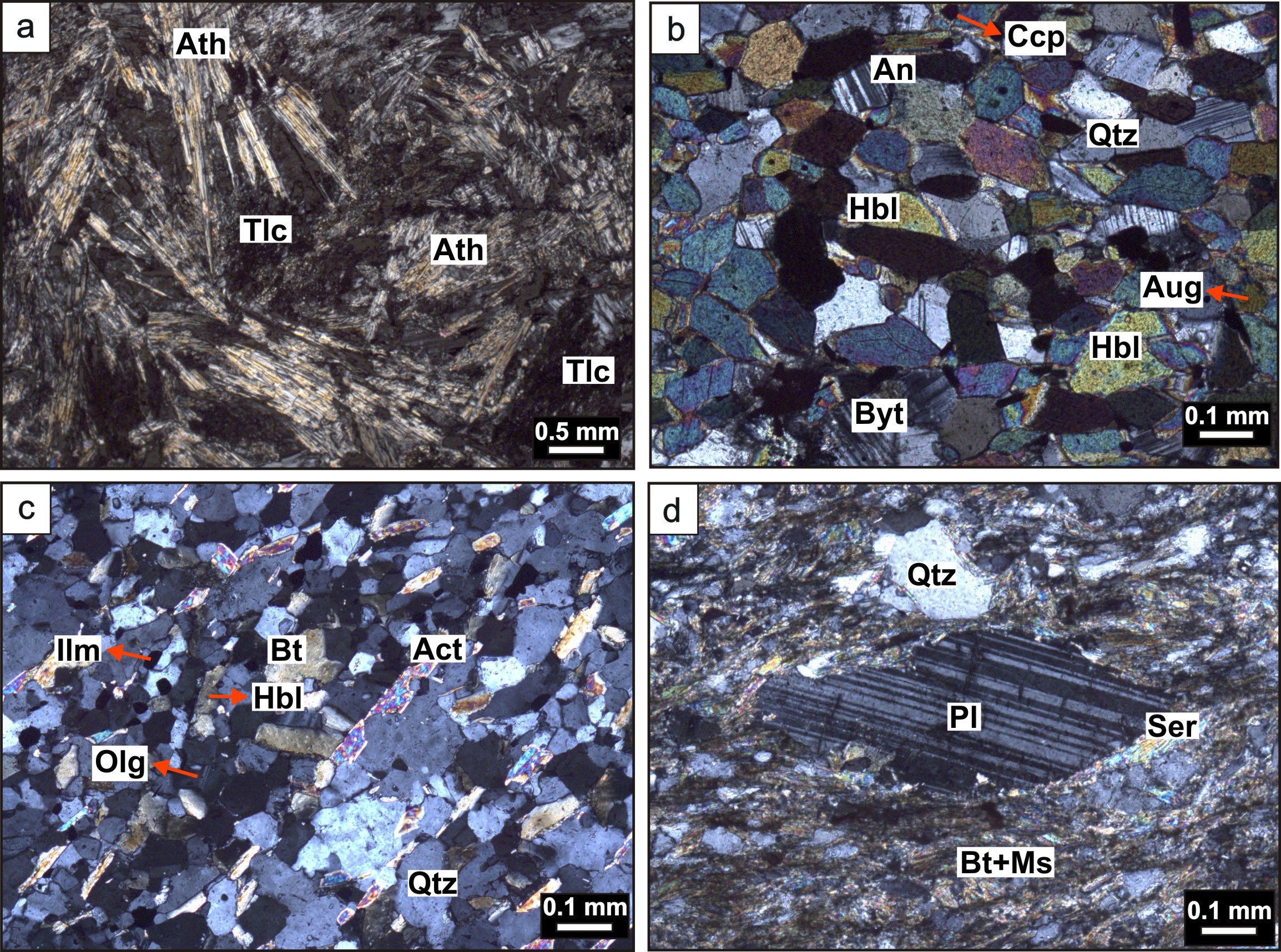
The lower sequence is composed of metakomatiite located at the base of the MNGB and comprises the ultramafic volcanic component of the MNGB. The metakomatiite has field relationships with the mafic volcanic rock of the middle sequence; however, these rocks are separated into different sequences due to the mineral content and the textural particularities. There are four restricted occurrences of metakomatiite in the central portion of the MNGB Figure 2, which are northeast of Mundo Novo city and northeast of Piritiba city. Generally, the metakomatiite of the MNGB has a relict spinifex texture composed of skeletal grains with planar growths that intersect each other Figures 3A and 4B and do not intercept former structures for igneous relicts’ texture in komatiites as Arndt [70] described. The fine-grained spinifex texture is identified only in hand samples or by using a hand lens or microscope. The metakomatiite of the MNGB has a light green color and a silky aspect and is not magnetic Figure 3A. The olivine and pyroxene crystals are entirely replaced by acicular and prismatic pseudomorphic grains of anthophyllite and tremolite (80% of the rock) with a grain size of 0.5 mm Figure 4A. The fine-grained groundmass is composed of talc and clinochlore (20% of the rock) without a preferred orientation. Traces of pyrite and pyrrhotite are dispersed in the sample.
Middle Sequence
The middle sequence is composed of metabasalt and, subordinately, tremolitite, calc-silicate rock, aluminous schist, BIF, ferruginous metachert, metadacite and subordinate metarhyolite; metabasalt and metadacite are the main topics of this study. Metabasalt and metadacite are the terms used in this paper to define the mafic and felsic volcanic components, respectively, of the middle sequence of the MNGB. This terminology was adopted based on the protolith because of its usefulness in determining the original nature of the rock, even though in many cases, a protolith name does not reflect the principal minerals and structural features of the rocks under observation [71]. Moreover, some occurrences of metavolcanic mafic rocks in the MNGB preserve primary structures such as pillow lava. Therefore, the term metabasalt is used in this manuscript rather than amphibolite, which is also correctly used if the texture and mineral content are considered as proposed by Fettes and Desmons [72]. The metabasalts are distributed along a north-south trend Figure 2 and are divided into two coeval groups based on petrography, supported by mineral chemistry analysis, and whole-rock chemical data. The first group, defined as the eastern metabasalt, occurs along the eastern portion of the MNGB and corresponds to the main outcrops of the sequence near Piritiba city and extending to Ruy Barbosa city Figure 2. The second group, defined as the western metabasalt, occurs along the western portion of the MNGB, mainly within the Fazenda Coqueiro deposit (Mundo Novo city), and in a restricted area with a north-south trend near Piritiba city Figure 2.
Figure 5: Classification diagrams of minerals in the eastern (blue symbols) and western (green symbols) metabasalts in the MNGB. A) Ternary diagram of feldspar: Ab: albite, Andes: andesine, An: anorthite, Byt: bytownite, Lab: labradorite, Olg: oligoclase, Or: orthoclase. B-C) Classification diagrams of the calcic amphiboles [61]. D) Classification diagram of pyroxenes [63].
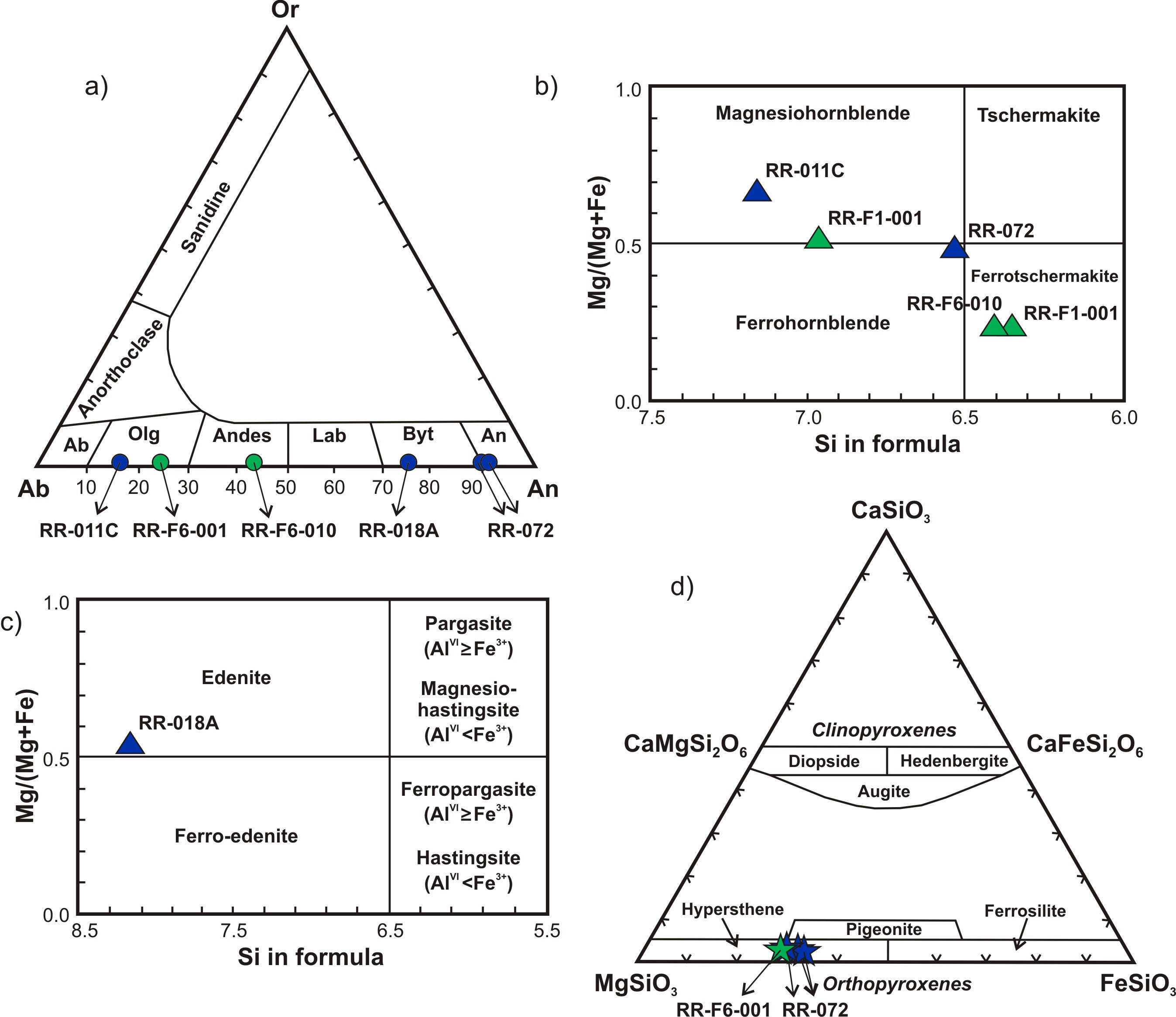
The eastern metabasalt preserves the pillow lava structures that occur in a large area to the south of the MNGB Figure 3B. It is composed of anorthite (15%), bytownite (15%), magnesiohornblende and ferrohornblende (40%), small amounts of oligoclase (5%) and low percentages (20% combined) of augite, edenite and quartz, as well as ilmenite and titanite as accessory minerals, and traces of pyrrhotite, chalcopyrite and igneous relicts of hypersthene micrograins identified only in microprobe analysis (5%; Table 2; Figures 5A, 5B, 5C and 5D). The minerals show polyhedral contacts with nematoblastic and granonematoblastic textures Figure 4B. The western metabasalt hosts the Zn and Pb sulfides of the Fazenda Coqueiro deposit, particularly in carbonate hydrothermal alteration zones, and is easily observed from drill hole samples Figure 3C. Based on petrography and mineral chemistry results, this rock is very fine grained and is mainly composed of oligoclase and andesine (50%), actinolite, magnesiohornblende and ferrotschermakite (30%) with a low percentage of quartz, biotite and igneous relicts of hypersthene micrograins (15%), as well as ilmenite and titanite as accessory minerals (5%; Table 2; Figures 5A, 5B, 5C and 5D). Traces of manganiferous ilmenite Figures 6A and 6B, pyrrhotite, pyrite, chalcopyrite, galena, sphalerite and arsenopyrite are also observed. The grains of biotite and actinolite are oriented and define highly developed planes of foliation Figure 4C.
Figure 6: a) Backscattered electron image with the analysis spot and b) the EDS spectrum of the manganiferous ilmenite present in the western metabasalt of the MNGB, as evidence of an ocean floor setting (sample RR-F16-027).
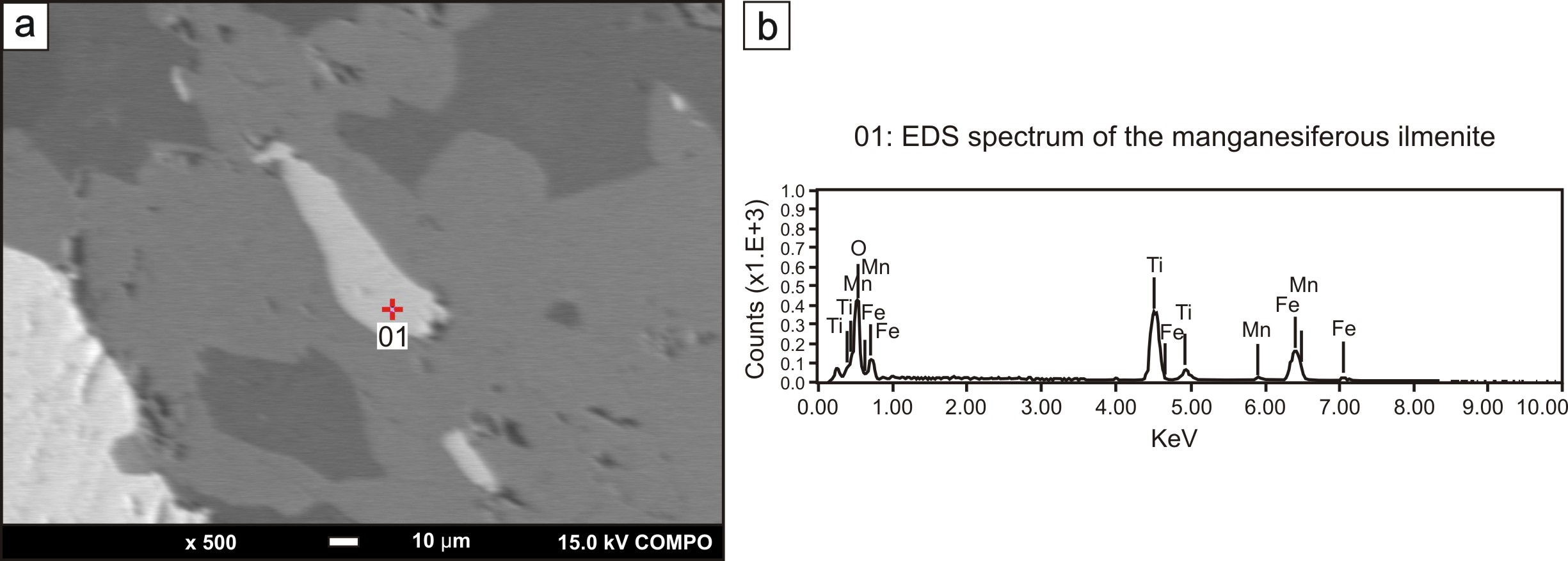
Metadacite and subordinate metarhyolite have restricted occurrences and correspond to the top of the MNGB middle sequence based on field relationships and a felsic mineral content typical of the later stages of volcanism. These units occur to the northeast of Piritiba city and were identified in a drill hole sample obtained by CBPM and in outcrops. These rocks are distributed along a northeast-southwest trend and are in contact with eastern metabasalt and ferruginous metachert Figure 2. The metadacite has a gray color, is strongly foliated and is not magnetic. This rock contains submillimetric porphyroclasts of plagioclase with sericitized borders and quartz (40% of the rock), which are dispersed in a fine-grained groundmass composed of quartz, plagioclase, biotite, muscovite and sericite (60% of the rock; Figures 3D and 4D). The subordinate metarhyolite has a gray color and is fine grained and foliated. It is composed of quartz (25%), K-feldspar (40%), plagioclase (20%), biotite (10%) and sericite (5%). This rock contains granolepidoblastic grains that are submillimetric and highly oriented, tabular crystals of plagioclase (usually sericitized) and grains of quartz, fine biotite and opaque minerals.
Whole-rock chemical characterization
The lithochemistry characterization of the metavolcanic rocks in the Neoarchean MNGB was used to refine the classification of rocks previously classified on the basis of petrography and mineral chemistry and to evaluate the related petrological processes and tectonic settings. Therefore, this analysis also included samples of metakomatiite of the lower sequence and eastern metabasalt, western metabasalt and metadacite of the middle sequence in the MNGB. The whole-rock chemical data of those rocks are listed in Tables 3, 4 and 5.
Mundo Novo Greenstone Belt
The bivariate diagrams of TiO2 and Al2O3 (the least mobile major elements), FeOt and MgO (mobile major elements), Ni (conservative trace element), Y (immobile trace element), and La and Ce (light REE) against Zr were drawn for the metakomatiite from the lower sequence and the eastern and western metabasalts and metadacite from the middle sequence of the MNGB; the diagrams are shown in Figure 7, and show important correlations. Zr was used as a crystal fractionation index because of its immobility during alteration and metamorphism and its large range of concentration in igneous suites, resulting from varying degrees of partial melting and fractional crystallization [22]. The Zr concentrations are 13-43 ppm in the metakomatiite, 40-192 ppm in the eastern and western metabasalts and 83-152 ppm in the metadacite. TiO2 defines a positive pattern versus Zr, and the eastern and western metabasalts form separate groups with the same slope. The Al2O3 diagram features a positive asymptotic pattern in which the metakomatiite samples plot near the origin, the metabasalt samples form a trend where the western metabasalt exhibits relatively high values of Al2O3, and the metadacite is approximately aligned in the trend. Four distinct and dispersed groups are formed in the FeOt plot, possibly because of the mobility of Fe during the alteration. The negative asymptotic patterns in the MgO and Ni diagrams form highly defined trends that can be explained by the fractional crystallization of olivine and pyroxene in the metakomatiite and eastern and western metabasalts. Y, La and Ce, which are considered immobile elements, show highly defined positive correlations versus Zr. Therefore, they were used to demonstrate that the metakomatiite, eastern and western metabasalts and metadacite from the MNGB may be related by fractional crystallization.
Lower Sequence
The metakomatiite of the MNGB is peridotitic, with MgO concentrations of 17-25 wt.% Figure 8a, and plots near the MgO vertex in the AFM diagram [73] Figure 8B. The chondrite normalized REE geochemical pattern [67] indicates enrichment in light REE in the metakomatiite in the MNGB, similar to the komatiite pattern from the Onverwacht Suite of the Barberton greenstone belt, South Africa [74] Figure 8d. The (La/Yb) N ratios in the MNGB’s metakomatiite show low values, with an average of approximately 5 and a minimum of 2.69. The low values of Nb (≤ 2.45 ppm), Ti (≤ 0.150 ppm) and the Ti/Zr ratio (≤ 0.012), in addition to the enrichment in U and Th can be observed in Figure 9A. High CaO/ Al2O3 ratios [75] in the metakomatiite of the MNGB, between 1.1 and 2.6, allow this rock to be classified as Al-depleted. In addition, the high (Gd/Yb) N ratios [75] between 1.09 and 1.60 indicate partial melting at high pressures and that the garnet remained in the residue during the melting process. In the multielement diagram normalized to N-MORB [68], the Cs, Ba, Th and U elements show high and anomalous concentrations in the metakomatiite Figure 9A, a flat pattern from Lu to Nd and a negative anomaly of Nb. The tectonic setting discrimination diagram of immobile elements, the Nb/Yb vs. Th/Yb diagram, indicates that the metakomatiite plots form a trend with other mafic volcanic rocks of the MNGB which extends from N-MORB point to volcanic arc array Figure 9E. This displacement of the plots oblique to MORB-ocean island basalt (OIB) array is a result of the transportation of subduction-mobile Th content [16,76].
Middle Sequence
The division of MNGB metabasalt into the two eastern and western groups, as previously discussed based on petrography, was further confirmed by the REE pattern. REE patterns are reliable because of the immobility of these elements during lowgrade metamorphism, weathering and hydrothermal alteration, and therefore, a degree of confidence can be placed in the obtained patterns [77]. The two groups have subtle differences. The eastern metabasalt has higher percentages of Fe and Ti than the western metabasalt Figure 8A, which suggests a small andesitic trend in some western metabasalt samples. In the AFM diagram, two distinct groups of samples are also present, both in the tholeiitic series field, with just two samples of western metabasalt plotting in the calc-alkalic series field Figure 8B. In the chondrite normalized REE diagram [67], the western metabasalt is more fractionated and enriched in light REE, with La normalized values near 100, than the eastern metabasalt, which shows a flat REE pattern and La normalized values between 10 and 40 Figures 8E and 8F. The fractionation difference is also observed in the average (La/Yb) N ratio: the western metabasalt has a value of 5.11 and the eastern metabasalt has a value of 1.91.
Figure 8: Lithochemical diagrams for MNGB rocks. A) Classification diagram [82]: FeT + Ti = FeO + Fe2O3 + TiO2; Al = Al2O3; Mg = MgO. B) AFM diagram, tholeiitic and calc-alkalic series [73], A = Na2O + K2O; F = FeO + 0.8998Fe2O3; M = MgO. C) SiO2 vs. Na2O + K2O classification diagram [79]. Chondrite-normalized REE diagram [67]: D) Metakomatiite in the MNGB lower sequence compared to the metakomatiite in the Barberton greenstone belt [74]; E) eastern metabasalt in the MNGB middle sequence; F) western metabasalt in the MNGB middle sequence; and G) metadacite and metarhyolite in the MNGB middle sequence.
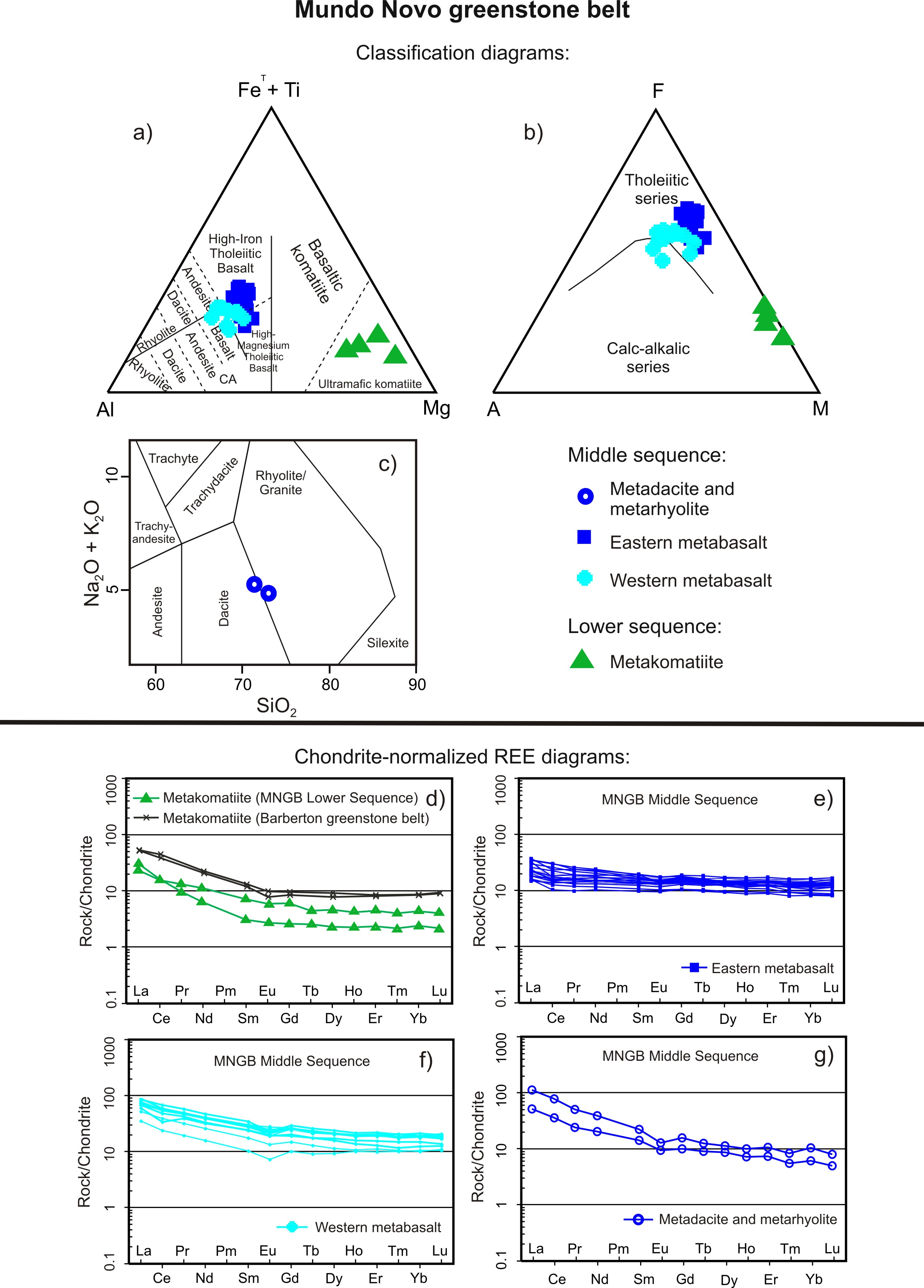
The geochemical patterns of the major and trace elements normalized to the fertile mantle MORB (FMM) values as a tectonic setting marker [78] are similar for both metabasalt types of the MNGB. The patterns in which normalized Nb (24.06) and Zr (11.48) > TiO2 (6.47) and in which Y (6.98) and Yb (7.04) ≥ CaO (3.00), Al2O3 (3.91) and V (4.20) into the two metabasalts are similar to the patterns in ocean floor basalts in a back-arc basin setting, as demonstrated in the Barberton greenstone belt [22]. In the multielement diagram of trace elements normalized to N-MORB [68] Figures 9B and 9C, both metabasalt groups show a flat pattern from Lu to Zr and a negative Ta anomaly. The difference between the two groups is subtle but consistent. The negative Ti anomaly is more accentuated in the western metabasalt than in the eastern metabasalt. The western metabasalt is more enriched in La, Ce and Nd than the eastern metabasalt, and the Th and Cs values of the western metabasalt (Th values greater than 10 and some values of Cs greater than 100) are greater than the values of the same elements in the eastern metabasalt (Th values smaller than 10 and Cs values between 20 and 30). The Nb/Yb vs. Th/Yb discrimination diagram of immobile elements in the eastern and western metabasalts of the MNGB indicates a trend that extends from N-MORB in the MORB-OIB array to the volcanic arc array, with a principal axis of dispersion of the plots oblique to the MORBOIB array Figure 9e. This pattern is similar to oceanic subductionrelated basalts of the Mariana Arc and Isua, Barberton and South Abitibi Archean greenstone belts Figure 9e. The eastern metabasalt has an IAT-type pattern, with some samples overlapping the MORB field, and the western metabasalt mainly features a MORB pattern with a few occurrences plotting in the within-plate basalt field (WPB; Figure 9F).
The felsic metavolcanic rocks of the middle sequence of the MNGB are classified as metadacite and subordinate metarhyolite in the SiO2 vs. Na2O + K2O diagram [79] Figure 8C. The chondrite normalized REE diagram [67] for these felsic metavolcanic rocks subtly slopes from Lu to Gd with a negative Eu anomaly Figure 8G, as indicated by the average Eu/Eu* ratio of 0.64. There is enrichment in light REE with strong fractionation from Sm to La, and the average of the (La/Yb) N ratio is 8.87. In the N-MORBnormalized multielement diagram [68] Figure 9D, the metadacite is enriched in Nb and Ta; high Cs, Ba, Th and U values, a negative Ti anomaly and moderate values of Hf (2.72-4.88 ppm) and Zr (83- 152 ppm) are shown. Moreover, the metadacite and subordinate metarhyolite plot in the volcanic arc field in the tectonic diagrams of Pearce et al. [80] Figures 9G and 9H and do not match the anorogenic field of the A-type granitoid diagram [81] Figure 9I according to the observations of metakomatiite and eastern and western metabasalts in the MNGB.
Figure 9: Lithochemical diagrams for MNGB rocks. A) Classification diagram [82]: FeT + Ti = FeO + Fe2O3 + TiO2; Al = Al2O3; Mg = MgO. B) AFM diagram, tholeiitic and calc-alkalic series [73], A = Na2O + K2O; F = FeO + 0.8998Fe2O3; M = MgO. C) SiO2 vs. Na2O + K2O classification diagram [79]. Chondrite-normalized REE diagram [67]: D) Metakomatiite in the MNGB lower sequence compared to the metakomatiite in the Barberton greenstone belt [74]; E) eastern metabasalt in the MNGB middle sequence; F) western metabasalt in the MNGB middle sequence; and G) metadacite and metarhyolite in the MNGB middle sequence.
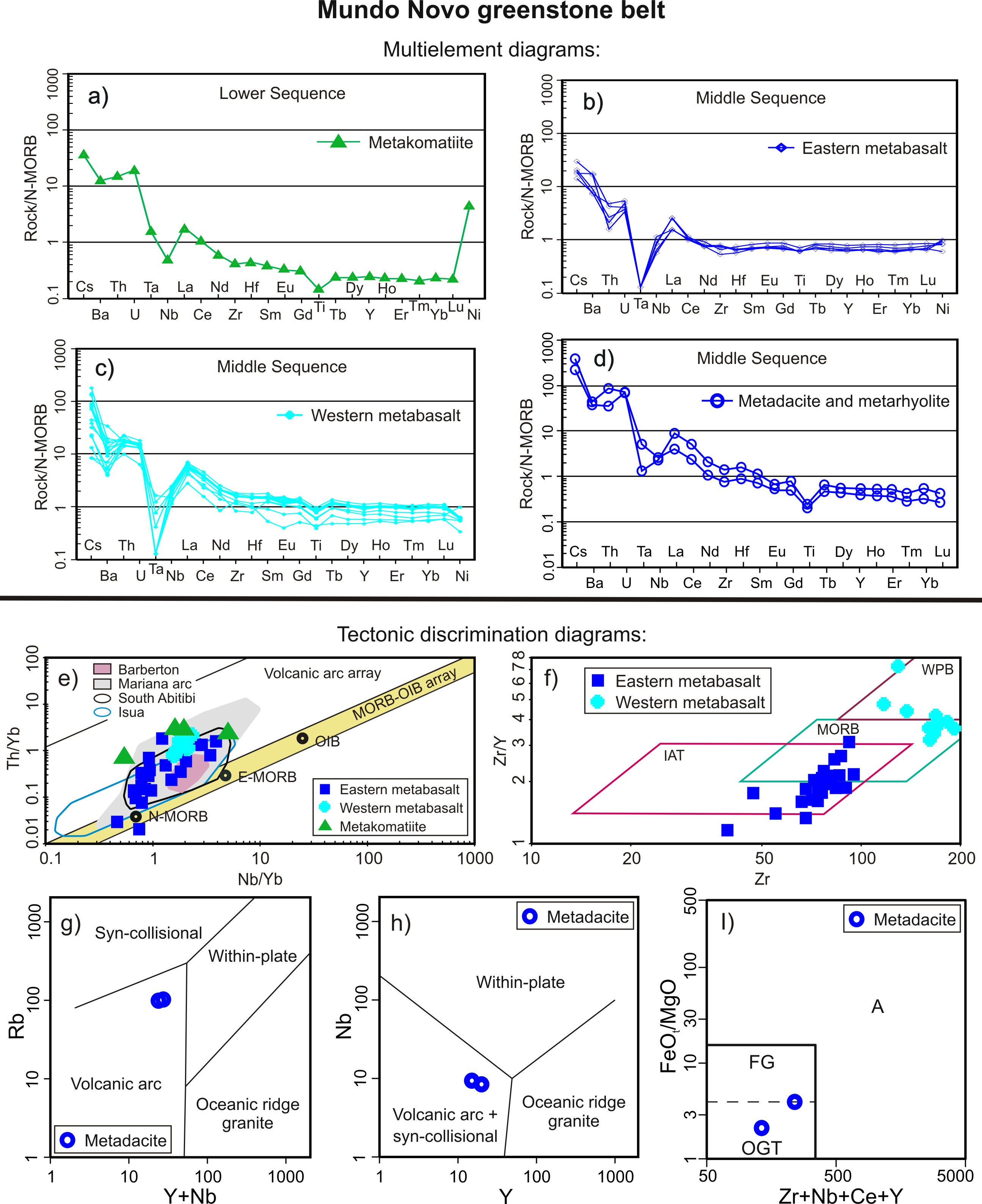
Discussion
The fine-grained texture of the metakomatiite in the MNGB is composed of skeletal grains with planar growths that intersect each other and do not intercept former structures, which indicates a relict spinifex texture preserved in chilled margins of the komatiite flows. This spinifex texture in the metakomatiite and the occurrence of pillow lava structure in the eastern metabasalt suggest rapid and subaquatic crystallization such as that widely observed and interpreted in other greenstone belt terrains [13]. The recovery of the volcanic rocks of the MNGB composed of metachert and BIF by lithological association, the absence of zircon xenocrysts, the manganiferous ilmenite occurrence in the western metabasalt and the carbonate and argilic-chloritic hydrothermal alteration zones developed on the western metabasalt indicate ocean floor settings [23,24,36,52,83].
Enrichments of Cs, Ba, Th and light REE relative to Ta, Nb, Zr, Hf, Ti, Y and heavy REE and the flat pattern from Lu to Nd in the multielement diagram Figures 9A, 9B and 9C show that the metakomatiite and the two metabasalts of the MNGB were generated from the metasomatized mantle above the subducting altered oceanic crust; Furnes et al. [22] interpreted a similar enrichment in the Onverwacht Suite in the Barberton greenstone belt. However, the enrichment of light REE relative to heavy REE in the chondrite-normalized REE diagram [67] Figures 8E and 8F was more accentuated in the tholeiitic-calc-alkalic western metabasalt relative to the tholeiitic eastern metabasalt, indicating stronger assimilation processes in the western metabasalt that must have been accentuated by the metamorphic events during the Rhyacian-Orosirian period.The effect of the heterogeneous crustal assimilation and metamorphism in the eastern and western metabasalts of the MNGB in the Paleoproterozoic may explain the differences in the mineral paragenesis. The eastern metabasalt, for example, is composed mainly of anorthite, bytownite, magnesiohornblende, ferrohornblende, augite, edenite and quartz; the western metabasalt comprises oligoclase, andesine, actinolite, ferrotschermakite, magnesiohornblende, biotite and quartz.
Both the eastern and western metabasalt samples of the MNGB plot in the IAT, MORB and WPB fields in the Zr vs. Zr/Y diagram Figure 9F; the eastern metabasalt plots in the IAT and MORB fields and the western metabasalt plots in the MORB and WPB field. The duplicity of fields by each metabasalt type appears initially uncertain; however, the proximity of settings during volcanism and the transition from one setting to other due to subsequent tectonic events with crustal assimilation must be considered. Therefore, the eastern and western metabasalts must be cogenetic and consistent with nearby intraoceanic settings in the MNGB, with different levels of crustal contamination during the formation in the oceanic crust by subduction components or intraoceanic contamination, and during metamorphism that probably occurred during the Rhyacian-Orosirian period. The stronger crustal assimilation in the western metabasalt displaces the plots to the WPB field, which is not observed in the eastern metabasalt plots. The plots of the metakomatiite and eastern and western metabasalts of the MNGB in the Nb/Yb vs. Th/Yb diagram feature a steep vector oblique to the MORB-OIB array Figure 9E. Those MNGB plots extend from near the N-MORB point, in the MORB-OIB array, and enter the field of the volcanic arc array, avoiding the OIB point. This plot distribution is similar to the South Abitibi [26,27], Barberton et al. [21,28,29] and Isua et al. [15,30] Archean greenstone belts Figure 9E, which are interpreted as an intraoceanic provenance as discussed in Pearce et al. [16], and similar to the modern Mariana intraoceanic arc-basin system [76]. Moreover, the MNGB geochemical pattern observed in the Nb/Yb vs. Th/Yb diagram shows that a subduction-related setting, in this case an intraoceanic arc, contributes to the increase in Th content in the rocks displacing the samples from the MORBOIB array to the volcanic arc array. However, the eastern metabasalt samples remaining in the MORB-OIB array register the initial ocean crust and back-arc setting in the MNGB and, with increasing island arc proximity, the plots displace from the MORB-OIB array. The samples most affected by tectonothermal Rhyacian-Orosirian events would be those most displaced from the MORB-OIB array and with higher Th content, such as the western metabasalt samples.
Acknowledgements
The author sends his cordial thanks to the Editors of this Journal for the invited inaugural issue short opinion article, along with his wishes for success and quick up growth.
References
- Charles E Harris, James H Starnes, Mark J Shuart (2002) Design and Manufacturing of Aerospace Composite Structures, State-of-the-Art Assessment. Journal of Aircraft 39(4): 545-560.
- Mrazova, Maria (2013) Innovations, technology and efficiency shaping the aerospace environment. INCAS Bulletin 5(2): 91-99.
- Ayesha Kausar, Irum Rafique, Bakhtiar Muhammad (2016) Review of Applications of Polymer/Carbon Nanotubes and Epoxy/CNT Composites. Polymer-Plastics Technology and Engineering 55(11): 1167-1191.
- Jiang S, Chen Y, Duan G, Mei C, Greiner A, et al. (2018) Electrospun nanofiber reinforced composites: a Review. Polymer Chemistry 9(20): 2685-2720.
- Young RJ, Kinloch IA, Gong L, Novoselov KS (2012) The mechanics of graphene nanocomposites: A review. Composites Science and Technology 72(12): 1459-1476.
- Lawal, Abdulazeez T (2019) Graphene-based nano composites and their applications. A review. Biosensors and Bioelectronics 141: 111384.
- D de la Iglesia, Diana Cachau, Raul, Garcia-Remesal, Maojo V (2013) Nanoinformatics knowledge infrastructures: Bringing efficient information management to nanomedical research. Comput Sci Disc 6(1): 14011.
- Statnano: Newsroom-Nanotechnology Publications of (2018): An Overview.
- Ma Xiaodan (2019) Hybrid superhydrophilic-superhydrophobic micro/nanostructures fabricated by femtosecond laser-induced forward transfer for sub-femtomolar Raman detection. Microsystems & Nanoengineering 5(1): 1-10.
- Koduru JR, Karri RR, Mubarak NM (2019) Smart Materials, Magnetic Graphene Oxide-Based Nanocomposites for Sustainable Water Purification. Sustainable Polymer Composites and Nanocomposites. Springer 759-781.
- Mouzakis DE (2018) Advanced Technologies in Manufacturing 3D-Layered Structures for Defense and Aerospace. In Lamination-Theory and Application.
- Kuang X, Roach DJ, Wu J, Hamel CM, Ding Z, et al. (2018) Advances in 4D Printing: Materials and Applications. Adv Funct Mater 29(2): 1805290.
- Wei Zhu, Thomas J Webster, Lijie G Zhang (2019) 4D printing smart biosystems for nanomedicine. Nanomedicine 14(13): 1643-1645.
- Minrui Chen, Weifeng Luo, Zhongqi Xu, Xueping Zhang, Bo Xie, et al. (2019) An ultrahigh resolution pressure sensor based on percolative metal nanoparticle arrays. Nature Communications 10(1): 4024.
- Varnava Christiana (2018) Nanowire networks crack on. Nature Electronics 1(6): 326.
- Varnava Christiana (2019) MEMS sensor in flight control. Nature Electronics 2(8): 322-322.
- Jang Y, Kim SM, Spinks GM, Kim SJ (2019) Carbon Nanotube Yarn for Fiber‐Shaped Electrical Sensors, Actuators, and Energy Storage for Smart Systems. Adv Mater 1902670.
- Dijkshoorn A, Werkman P, Welleweerd M, Wolterink G, Eijking B, et al. (2018) Embedded sensing: integrating sensors in 3-D printed structures. J Sens Sens Syst 7: 169–181.
- Kuang X, Roach DJ, Wu J, Hamel CM, Ding Z, et al. (2018) Advances in 4D Printing: Materials and Application. Adv Funct Mater 29(2): 1805290.
- Zhu W, Thomas J Webster, Lijie G Zhang (2019) 4D printing smart biosystems for nanomedicine. Nanomedicine 14(13): 1643-1645.
- Jacky FC Loo, Aaron HP Ho, Anthony PF Turner, Wing Cheung Mak C (2019) Integrated printed microfluidic biosensors. Trends in biotechnology 37(10): 1104-112.
- Sharma R, Singh R, Batish A (2019) Study on barium titanate and graphene reinforced PVDF matrix for 4D applications. Journal of Thermoplastic Composite Materials 0892705719865004.
- Vlăsceanu GM, Iovu H, Ioniţă M (2019) Graphene inks for the 3D printing of cell culture scaffolds and related molecular arrays. Composites Part B: Engineering 162: 712-723.
- Lui YS, Sow WT, Tan LP, Wu Y, Lai Y, et al. (2019) 4D printing and stimuli-responsive materials in biomedical aspects. Acta biomaterialia 92: 19-36.
- Koons GL, Mikos AG (2019) Progress in three-dimensional printing with growth factors. Journal of controlled release 295: 50-59.

Top Editors
-

Mark E Smith
Bio chemistry
University of Texas Medical Branch, USA -

Lawrence A Presley
Department of Criminal Justice
Liberty University, USA -

Thomas W Miller
Department of Psychiatry
University of Kentucky, USA -

Gjumrakch Aliev
Department of Medicine
Gally International Biomedical Research & Consulting LLC, USA -

Christopher Bryant
Department of Urbanisation and Agricultural
Montreal university, USA -

Robert William Frare
Oral & Maxillofacial Pathology
New York University, USA -

Rudolph Modesto Navari
Gastroenterology and Hepatology
University of Alabama, UK -

Andrew Hague
Department of Medicine
Universities of Bradford, UK -

George Gregory Buttigieg
Maltese College of Obstetrics and Gynaecology, Europe -

Chen-Hsiung Yeh
Oncology
Circulogene Theranostics, England -
.png)
Emilio Bucio-Carrillo
Radiation Chemistry
National University of Mexico, USA -
.jpg)
Casey J Grenier
Analytical Chemistry
Wentworth Institute of Technology, USA -
Hany Atalah
Minimally Invasive Surgery
Mercer University school of Medicine, USA -

Abu-Hussein Muhamad
Pediatric Dentistry
University of Athens , Greece

The annual scholar awards from Lupine Publishers honor a selected number Read More...




